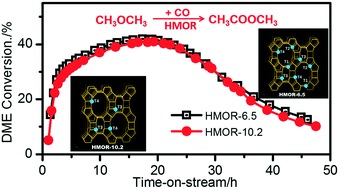Regulating the location of framework aluminium in mordenite for the carbonylation of dimethyl ether†
Abstract
Mordenites with framework Si/Al ratios of 6.5–10.2 were hydrothermally synthesized by simply varying the concentrations of silica and alumina sources in the raw gel without using any template. However, their catalytic performance for dimethyl ether carbonylation remained almost identical. Structural analysis and IR characterization revealed that the framework Al atoms preferentially located on the T3 and T4 sites in the 4-ring unit at higher Si/Al ratios, while they positioned on all the four T-sites at lower Si/Al ratios. Accordingly, the correlation between the activity and the specific location of framework Al atoms was established: the Al atom on the T3-site of the 8-MR channel was the active center for DME carbonylation, while the Al atom at the T4-site of the 12-MR channel induced the deactivation via coking. The superfluous Al atoms at T1 and T2 sites did not contribute to either DME conversion or coke deposition, simply acting as spectators. With this regard, mordenite having a framework Si/Al ratio of 11, in which each 8-MR and 12-MR possess of one Al atom siting on the T3 and T4 sites, respectively, would achieve its catalytic activity for DME carbonylation.



 Please wait while we load your content...
Please wait while we load your content...